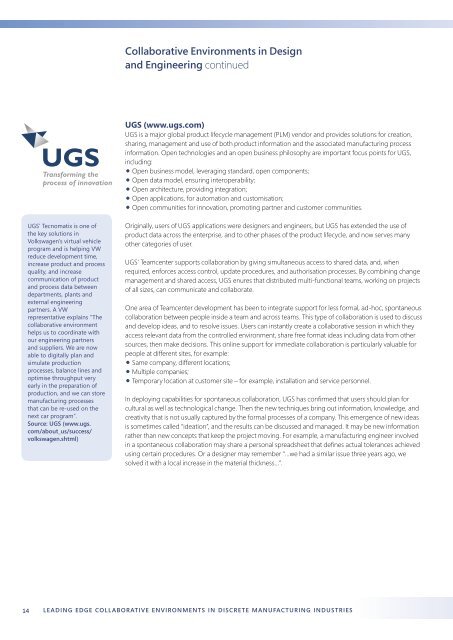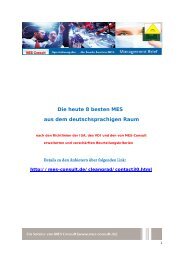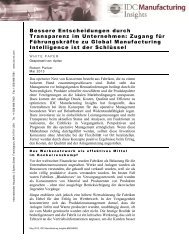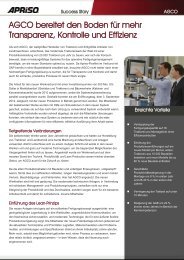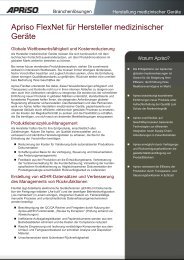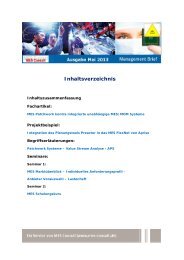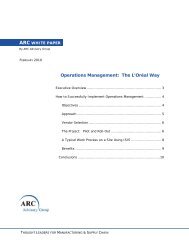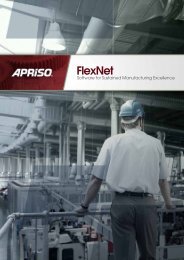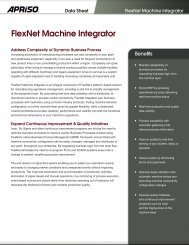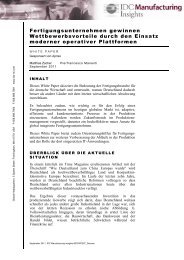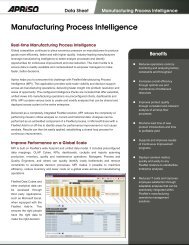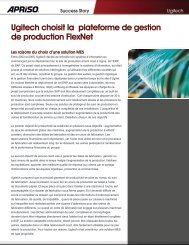Collaboration - Apriso
Collaboration - Apriso
Collaboration - Apriso
You also want an ePaper? Increase the reach of your titles
YUMPU automatically turns print PDFs into web optimized ePapers that Google loves.
14<br />
UGS’ Tecnomatix is one of<br />
the key solutions in<br />
Volkswagen’s virtual vehicle<br />
program and is helping VW<br />
reduce development time,<br />
increase product and process<br />
quality, and increase<br />
communication of product<br />
and process data between<br />
departments, plants and<br />
external engineering<br />
partners. A VW<br />
representative explains “The<br />
collaborative environment<br />
helps us to coordinate with<br />
our engineering partners<br />
and suppliers. We are now<br />
able to digitally plan and<br />
simulate production<br />
processes, balance lines and<br />
optimise throughput very<br />
early in the preparation of<br />
production, and we can store<br />
manufacturing processes<br />
that can be re-used on the<br />
next car program”.<br />
Source: UGS (www.ugs.<br />
com/about_us/success/<br />
volkswagen.shtml)<br />
Collaborative Environments in Design<br />
and Engineering continued<br />
UGS (www.ugs.com)<br />
UGS is a major global product lifecycle management (PLM) vendor and provides solutions for creation,<br />
sharing, management and use of both product information and the associated manufacturing process<br />
information. Open technologies and an open business philosophy are important focus points for UGS,<br />
including:<br />
• Open business model, leveraging standard, open components;<br />
• Open data model, ensuring interoperability;<br />
• Open architecture, providing integration;<br />
• Open applications, for automation and customisation;<br />
Open communities for innovation, promoting partner and customer communities.<br />
•<br />
Originally, users of UGS applications were designers and engineers, but UGS has extended the use of<br />
product data across the enterprise, and to other phases of the product lifecycle, and now serves many<br />
other categories of user.<br />
UGS’ Teamcenter supports collaboration by giving simultaneous access to shared data, and, when<br />
required, enforces access control, update procedures, and authorisation processes. By combining change<br />
management and shared access, UGS enures that distributed multi-functional teams, working on projects<br />
of all sizes, can communicate and collaborate.<br />
One area of Teamcenter development has been to integrate support for less formal, ad-hoc, spontaneous<br />
collaboration between people inside a team and across teams. This type of collaboration is used to discuss<br />
and develop ideas, and to resolve issues. Users can instantly create a collaborative session in which they<br />
access relevant data from the controlled environment, share free format ideas including data from other<br />
sources, then make decisions. This online support for immediate collaboration is particularly valuable for<br />
people at different sites, for example:<br />
• Same company, different locations;<br />
• Multiple companies;<br />
Temporary location at customer site – for example, installation and service personnel.<br />
•<br />
In deploying capabilities for spontaneous collaboration, UGS has confirmed that users should plan for<br />
cultural as well as technological change. Then the new techniques bring out information, knowledge, and<br />
creativity that is not usually captured by the formal processes of a company. This emergence of new ideas<br />
is sometimes called “ideation”, and the results can be discussed and managed. It may be new information<br />
rather than new concepts that keep the project moving. For example, a manufacturing engineer involved<br />
in a spontaneous collaboration may share a personal spreadsheet that defines actual tolerances achieved<br />
using certain procedures. Or a designer may remember “…we had a similar issue three years ago, we<br />
solved it with a local increase in the material thickness…”.<br />
LEADING EDGE COLL ABORATIVE ENVIRONMENTS IN DISCRETE MANUFACTURING INDUSTRIES


